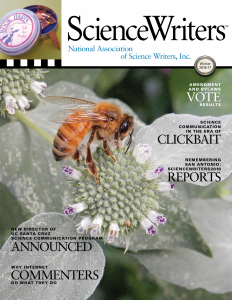By Kathleen O’Neill
Scientists and professionals at research institutions eager to inform the public about their work need to go where the readers or, increasingly, the viewers are: a range of social media platforms.
Instead of driving traffic to their websites, a panel of public information officers, editors, and journalists recommend creating science content specifically for use on Snapchat, Facebook Live, Twitter, Tumblr, and other social media outlets, emphasizing the use of images and multimedia.
Content needs to be authentic and transparent, to counter the growing distrust of scientists and institutions, one expert said.“What drives our coverage?” said Nancy Shute, co-editor of National Public Radio’s health Shots blog. “Visuals, visuals, visuals. Social is a visual medium.” When her team compared posts that included original art with those that relied on stock art or lacked images altogether, they found those with original art had 160 percent more page views. That convinced the science and health team to increase their budget for original art, videos, and GIFs — popular short videos and animations — for use on social media and the blogs, Shute said.
The panel discussion was part of a science communication seminar on Dec. 2, 2016, entitled Communicating Science in the Clickbait Era, organized by EurekAlert!, AAAS’s science news service. The seminar was also webcast live and drew more than 250 participants.
A preference for visuals may also be why four-year-old Snapchat overtook Twitter in 2016 with more than 150 million daily active users. Snapchat also has the largest share of 18- to 24-year-olds on social media, said Brian Lin, director of editorial content strategy for EurekAlert!.
Science institutions are particularly interested in reaching those younger audiences, since “their engagement with science could have an enormous impact on our future,” said Lin, who moderated the panel discussion.
Increasingly, data and science information is being conveyed in graphics alone, without an accompanying textual story. Shute said they sometimes create data-rich “charticles,” to convey health disparities, for example, while Laz Gamio, a graphics editor for the Washington Post, said he is a fan of making “infoGIFs” for Twitter.
Jason Townsend, NASA deputy social media manager, said his team takes advantage of trending topics, anniversaries, and other connections in the news to draw in new audiences. For instance, it allowed British boy band One Direction to shoot a music video about a space mission to Mars at NASA facilities. NASA’s social media team filmed their own short videos of the band participating in astronaut training, which attracted a lot of new, young followers, particularly girls, he said. “A lot of folks groan, ‘Why are you talking about One Direction?’ … You should talk about space,” Townsend said. “But you know … we’re trying to inspire the next generation of explorers here.”
David Cameron, director of media relations at Harvard University, said his team has begun giving “behind the scenes” tours of laboratories and other campus locations on Facebook Live. While the quality is “unspectacular,” he said, the new format offers a sense of authenticity that polished videos don’t.
A conversational tone is what makes Buzzfeed News so popular with young viewers, said Jess Naudziunas, senior video editor for the site. And while the site may top science posts with a “click-bait-y” headline such as “15 Things People With Arthritis Want You To Know,” what follows is an accurate and well-researched news story, she said.
Beyond informing audiences, scientists and institutions need to engage with the public to increase trust in science, Cameron said. Trust is generated when scientists seem authentic and when their audience feels they might share some of the same values, he said. However, he cited a recent survey of AAAS members that found that the number one reason scientists participate in public outreach was to “defend science.” Their second most popular reason was “to inform,” followed by “to excite” and “build trust.”
“If science is under attack, you should focus on building trust, not going on the defensive,” Cameron said. “I think we need to communicate authenticity.”
Shute added that while some scientists and communicators may rightfully resist exaggerated headlines, “ethical clickbait” that is “appropriately whimsical” can go a long way to attracting a wider audience not typically engaged with science.
“Experts Outline Three Ways to Boost Science Communication,” AAAS.org, Dec. 8, 2016.
(NASW members can read the rest of the Winter 2016-17 ScienceWriters by logging into the members area.) Free sample issue. How to join NASW.


